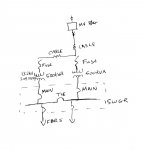Magic Gorge
Member
- Location
- Lexington, KY
I have a feeder breaker relay feeding a 500kVA transformer, which is daisy chained to another 500kVA transformer. Both transformers are fused on the primary. Both transformers feed a Switchgear with main-tie-main breaker configuration, and all breakers are normally closed. When I plot the device curves, would it be proper to plot the main breakers at twice the current? Even though the main-tie-main are all 2000A, this would show the mains like 4000A devices.


